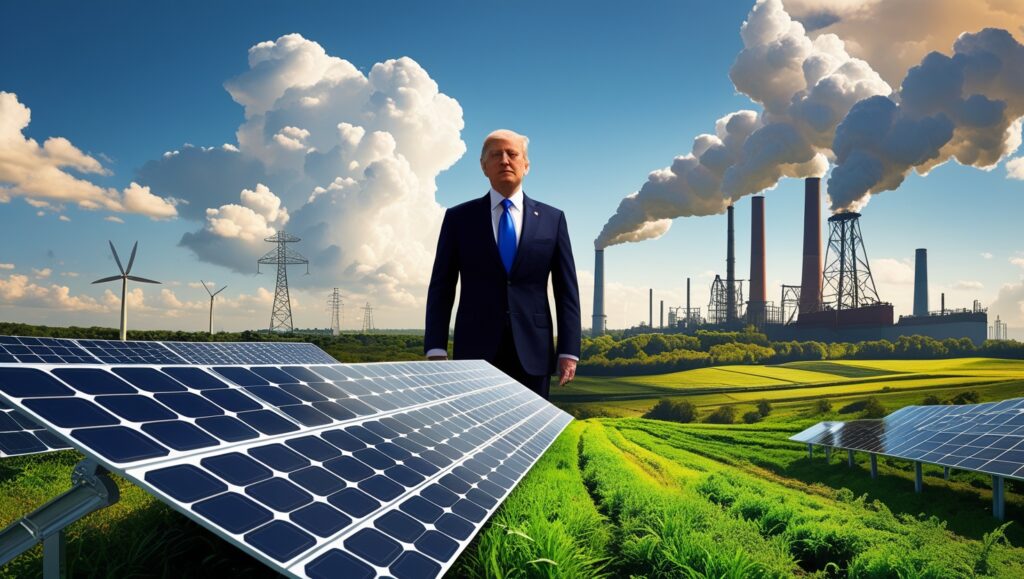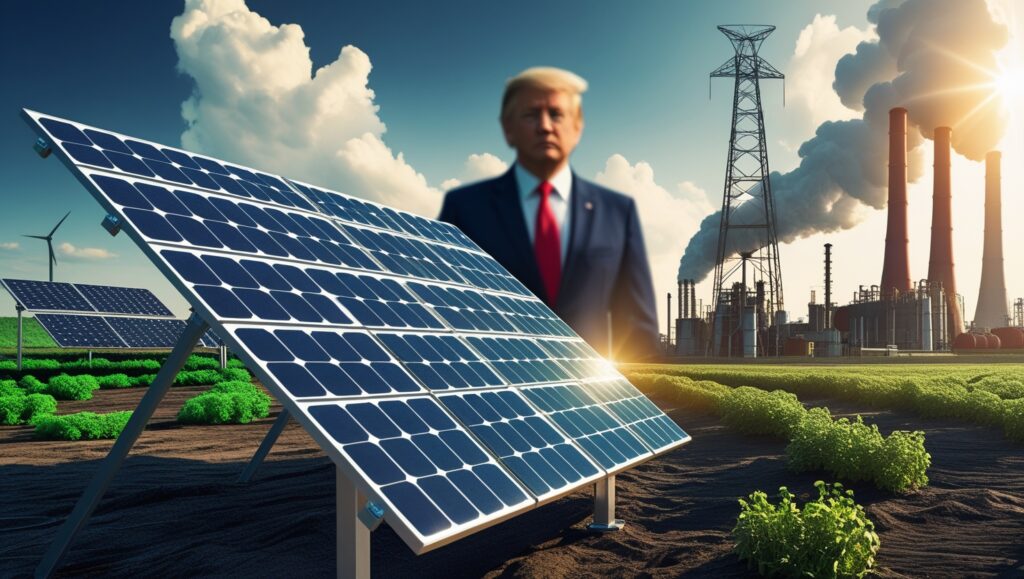The renewable energy sector, particularly solar, has seen unprecedented growth in recent years. Declining costs, advancements in technology, and government-backed incentives have propelled solar energy into the mainstream as a cornerstone of the global clean energy transition. Yet, the industry’s future is not immune to shifts in political leadership.
The possibility of a Trump 2.0 administration, with a new Secretary of Energy at the helm, raises important questions: Will solar energy continue to thrive, or could political headwinds stall its momentum? Exploring the potential challenges and opportunities under such an administration sheds light on how the solar sector might navigate uncertain terrain.
Understanding Trump’s Energy Policies
During Donald Trump’s first term, his administration placed a significant emphasis on bolstering traditional energy industries, such as coal, oil, and natural gas. This approach aligned with the broader objective of achieving “energy independence” through domestic production. Several key policy actions underscored this focus:
- Environmental Rollbacks: The Trump administration repealed several regulations aimed at reducing emissions, most notably the Clean Power Plan, which was designed to cut carbon pollution from power plants.
- Paris Climate Agreement Withdrawal: In 2017, the U.S. formally exited the international pact, signaling a step back from global climate commitments.
- Fossil Fuel Advocacy: Policies and initiatives during this period prioritized the development and expansion of fossil fuel resources, often at the expense of renewable energy initiatives.
While solar energy wasn’t explicitly targeted, these policies created an environment where clean energy technologies received less federal support. Tax incentives for renewables were largely untouched, but the overall focus shifted away from accelerating the adoption of solar and other green technologies.

The Role of the Secretary of Energy
The Secretary of Energy is a pivotal figure in determining the direction of the nation’s energy policies. This role involves overseeing a wide range of responsibilities, including funding energy research, managing energy-related initiatives, and setting the strategic vision for the Department of Energy (DOE). As a result, the Secretary’s priorities can have a profound impact on the pace and focus of renewable energy adoption, including solar energy.
During Trump’s first term, then-Secretary of Energy Rick Perry championed an “all-of-the-above” energy strategy. While this approach ostensibly supported a mix of energy sources, critics noted that it heavily favored fossil fuel industries, emphasizing coal and natural gas exports. Renewables, including solar, often found themselves sidelined in this energy agenda.
If a Trump 2.0 administration appoints a new Secretary of Energy with similar priorities, the solar industry could face several challenges:
- Reduced Incentives: Federal tax credits and subsidies for solar projects could be deprioritized, making renewable energy less competitive compared to fossil fuels.
- Research Funding Cuts: DOE support for solar technology innovation and development might decrease, slowing advancements in efficiency and affordability.
- Regulatory Shifts: Changes to policies like net metering, grid interconnection, and environmental regulations could disadvantage solar adoption at both residential and commercial levels.
These potential policy directions underscore how the priorities of the Secretary of Energy can directly influence solar industry growth, either accelerating or impeding its progress.
Potential Challenges for Solar Energy
As the solar industry continues to play a significant role in the transition to clean energy, potential policy shifts under a Trump 2.0 administration could introduce several hurdles. These challenges may directly impact the growth, accessibility, and competitiveness of solar energy in the U.S.
1. Reduced Federal Support
Federal incentives like tax credits, grants, and subsidies have been instrumental in encouraging widespread solar adoption. Programs such as the Solar Investment Tax Credit (ITC) have significantly reduced the upfront costs of solar installations for homeowners and businesses. However, a Trump 2.0 administration might scale back or eliminate these initiatives, making solar installations less financially viable for many. Without federal backing, smaller solar companies could struggle, and adoption rates could decline, particularly in lower-income communities.
2. Focus on Fossil Fuels
Trump’s energy policies have historically prioritized fossil fuel development under the banner of “energy dominance.” This emphasis could lead to:
- Increased oil and gas leasing on federal lands, often at the expense of renewable energy projects.
- Legislative barriers that challenge the integration of solar and wind projects into the energy mix.
- Policies favoring fossil fuel subsidies, potentially creating an uneven playing field for renewable energy developers.
Such measures would likely slow the progress of solar initiatives and undermine efforts to achieve a cleaner energy grid.
3. Trade and Tariffs
Tariffs imposed during Trump’s first term on imported solar panels and components disrupted the market, driving up costs for solar installations and creating uncertainty for developers. A similar approach under a Trump 2.0 administration could:
- Increase the price of imported solar panels, impacting affordability.
- Create supply chain uncertainties, delaying projects and reducing investor confidence.
- Force the industry to rely more heavily on domestic manufacturing, which, while beneficial in the long term, may not meet immediate demand.
These potential trade policies could present significant obstacles to the scalability and affordability of solar energy in the short term.
4. Weakened Climate Goals
Federal leadership is critical in setting the tone for climate action and renewable energy adoption. A rollback of climate commitments, such as re-entering the Paris Climate Agreement or advancing aggressive carbon reduction targets, could reduce momentum for solar and other renewables. While states and municipalities may continue to champion clean energy initiatives, the absence of federal alignment could hinder nationwide progress and investment in the solar sector.

Opportunities Amid Challenges
While potential policy shifts under a Trump 2.0 administration could introduce obstacles, the solar industry is uniquely positioned to navigate such challenges and continue its upward trajectory. Several key factors may enable the sector to thrive despite an unfavorable federal environment.
1. State and Local Initiatives
States and municipalities have increasingly taken the lead in promoting renewable energy. Progressive policies at these levels could act as a counterbalance to federal rollbacks. For instance:
- California’s renewable energy mandate aims for 100% clean energy by 2045, driving significant investment in solar.
- Texas has emerged as a surprising leader in renewable energy, with its abundant sunshine and pro-business environment encouraging solar development.
- New York’s Climate Leadership and Community Protection Act sets ambitious renewable energy targets, bolstering solar projects statewide.
Local governments are also offering incentives like property tax exemptions and rebates to make solar more accessible. This decentralized approach ensures that momentum for solar adoption continues, even without federal backing.
2. Market-Driven Growth
The economics of solar energy are increasingly compelling. Over the past decade, the cost of solar installations has plummeted, making it competitive with or even cheaper than fossil fuels in many regions. This market-driven growth is fueled by:
- The potential for long-term savings on energy bills.
- Growing awareness of solar as a reliable and affordable energy source.
- Opportunities for energy independence, appealing to both businesses and homeowners.
Even in the absence of federal incentives, the cost advantages of solar are likely to sustain demand.
3. Corporate Demand for Sustainability
Major corporations are adopting sustainability initiatives that include ambitious clean energy goals. Businesses are turning to solar to:
- Reduce their carbon footprint.
- Meet investor and consumer expectations for environmental responsibility.
- Protect against rising energy costs through long-term contracts like Power Purchase Agreements (PPAs).
High-profile companies such as Amazon, Google, and Walmart are heavily investing in solar energy, creating a ripple effect that drives demand across industries. This corporate push can help buoy the solar industry even during periods of federal uncertainty.
4. Technological Innovation
Breakthroughs in solar technology continue to enhance the sector’s potential. Innovations such as:
- High-efficiency solar panels that generate more energy per square foot.
- Energy storage solutions, like advanced batteries, to store excess solar power for later use.
- Smart grid technology, improving the integration of solar into the existing energy infrastructure.
These advancements are making solar more practical, scalable, and economically viable, reducing reliance on government incentives and creating new opportunities for growth.

What Can You Do?
Whether you’re a solar industry professional or a homeowner considering solar energy, preparing for potential shifts in policy is essential. With proactive measures, you can mitigate challenges and continue to benefit from solar power’s many advantages.
1. Stay Informed
Understanding the political and regulatory landscape is key to making informed decisions:
- Monitor policy updates: Follow news about federal energy policies and how they may impact solar incentives.
- Engage with industry reports: Stay updated on market trends and forecasts to anticipate shifts in costs or demand.
- Consult experts: Work with solar professionals who are well-versed in navigating local and federal regulations.
Being informed will allow you to adapt quickly to any changes and make the most of opportunities.
2. Advocate for Solar
Your voice can make a difference in promoting renewable energy at various levels:
- Support local and state initiatives: Advocate for clean energy programs, such as solar rebates or renewable portfolio standards, in your community.
- Engage with policymakers: Reach out to your representatives to express your support for renewable energy policies.
- Join solar advocacy groups: Participate in organizations that champion the expansion of renewable energy and educate the public.
Grassroots efforts can help maintain momentum for solar adoption, even in a challenging federal environment.
3. Explore Financial Options
Acting now can help you secure existing benefits before potential policy changes take effect:
- Maximize tax credits: Take advantage of federal incentives like the Solar Investment Tax Credit (ITC) while they’re still available.
- Research grants and rebates: Look into state-specific programs offering financial support for solar installations.
- Consider financing options: Explore solar loans, leases, or Power Purchase Agreements (PPAs) to make solar more affordable upfront.
By leveraging current incentives, you can reduce the cost of installation and ensure a quicker return on investment.
4. Invest in Innovation
For businesses within the solar industry, staying competitive requires a focus on innovation:
- Prioritize R&D: Develop more efficient panels, storage solutions, and installation processes to attract cost-conscious customers.
- Diversify offerings: Expand your product portfolio to include emerging technologies like floating solar or agrivoltaics.
- Enhance customer experience: Invest in tools and services that make solar adoption simpler, such as advanced monitoring systems or streamlined financing options.
Innovation will help businesses maintain a competitive edge, even in a shifting policy environment.
Conclusion
The prospect of a Trump 2.0 administration and a new Secretary of Energy brings a mix of uncertainty and potential challenges for the solar industry. However, the resilience and adaptability of the renewable energy sector cannot be overstated. Solar power has evolved from a niche solution to a mainstream energy source, driven by a combination of technological breakthroughs, declining costs, and growing consumer demand.
While federal policy shifts could create obstacles, the solar industry’s foundation remains strong. State-level initiatives, corporate sustainability commitments, and innovative advancements are powerful drivers that continue to propel solar energy forward. Even in the face of potential headwinds, the industry has proven its ability to adapt and thrive in changing landscapes.
For stakeholders, the key lies in being proactive—staying informed, advocating for supportive policies, and investing in innovation. By taking these steps, the solar sector can not only weather political shifts but also emerge stronger, reaffirming its role as a cornerstone of a sustainable energy future.
The path to a cleaner, greener tomorrow isn’t without challenges, but the solar industry’s determination and ingenuity ensure it remains a beacon of progress. Together, we can navigate these uncertainties and continue to harness the power of the sun for generations to come.









